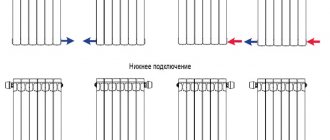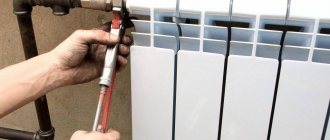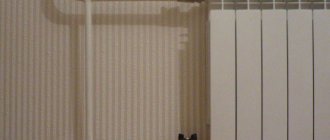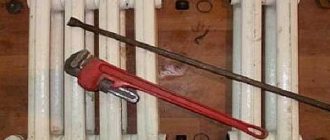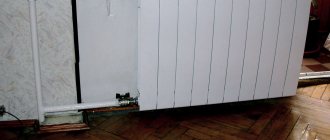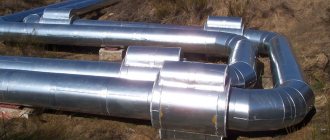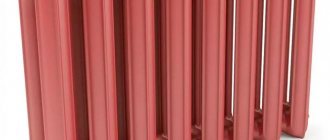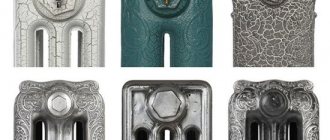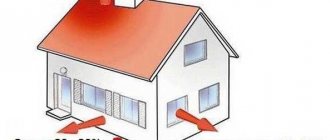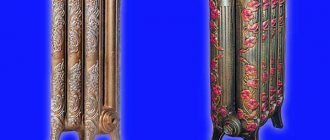At the very beginning, you need to find out how much primer solution and paint you need to use to paint the battery. This can be found out by calculating the area of the heating radiator. Next, look at the recommendations indicated on the paint can. They always indicate how much paint can be used per 1 square meter. m . It is impossible to measure the battery area yourself. This does not need to be done, because manufacturers indicate the heating surface area of the section. Since every square centimeter of the section is heated, this area and the area of the entire surface of the section. One edge of the MS-140-500 battery has an area of 0.244 square meters. m. A modification of this model with an interaxal distance of 300 mm has sections with an area of 0.208 sq. m.
To determine the total surface area of a cast iron battery, you must:
- Find out the model name of the installed battery and preferably the manufacturer (this is because sections produced by manufacturers of the same models have different depths and widths).
- Set the heating area of 1 rib.
- Multiply the number of sections by the area. If the MS-140-500 radiator has 10 fins, then the surface area will be 2.44 square meters. m.
Having made the calculation, they determine the amount of composition and primer, buy them and paint. Paint should be taken with reserve, because everyone applies a layer with a different thickness.
Calculation of the painting area of a cast iron radiator
Old cast iron batteries can disappoint aesthetes with their unattractive appearance, which is caused by fading, cracks and oil paint peeling off.
When was this the only paint used to paint cast iron radiators? Of course, the unattractive appearance is not an unsolvable problem, because the beauty of the heating device can be easily restored by painting the surface of the cast iron radiator. Heating systems are available in every apartment. There are many types of radiators. They differ in weight, design, size, heat dissipation and other characteristics. Cast iron radiators are reliable and practical. Houses commissioned under the USSR were equipped with batteries that perform their functions excellently and heat the apartment space during the cold season.
Diagram of a heating radiator.
The advantages of cast iron radiators are high heat transfer, corrosion resistance, and durability.
Once upon a time, batteries were painted with oil paints. Under the influence of constant high temperatures and significant changes, they fade, deteriorate, and crumble; batteries take on an unattractive, unkempt appearance. The question arises about their restoration.
So, you need to paint an old cast iron radiator battery. What is needed for this?1. Preparatory work: removing dust and old paint using a chemical method. First, wipe off the dust using improvised means, you can use a brush for cleaning dishes, wet gauze folded into a rope. One end of it is threaded through the internal transverse plates of the radiators;
The 2 ends of the tourniquet are taken with the left and right hands respectively; The device is cleaned of dust by alternately pulling the gauze from the left hand to the right. Then you can remove layers of flaking old paint and traces of corrosion. If the area of the old paint coating is small, the paint can be removed mechanically (by manual stripping).
For this you need:
- sandpaper;
- file;
- brush with metal bristles.
Can also be applied:
- grinder;
- special attachment for the drill.
Cleaning cast iron batteries before painting is a mandatory process, because... Paint will not be able to hide the unevenness of the radiators.
The advantages of the mechanical method are its versatility: it can be carried out on functioning warm batteries, on cold ones connected and not connected to the heating system; it is applicable for any paint and varnish coatings (thermal spray enamels, oil paints, nitro paints, paints based on various resins, etc.)
If the surface area of the old paint is large, it is possible to remove the entire layer using chemical means. They are solvents, acids and alkalis. For this method of removing old paint you will need:
- gloves;
- respirator;
- special curved brush;
- cycle;
- brush with metal bristles;
- putty knife.
Using a brush, the substance is applied to the paint to be removed. The application process is sometimes repeated several times at intervals of 5-30 minutes. After some time, the old coating completely dissolves or softens. It is removed with a spatula, brush, or scraper. The cleaned surface of cast iron radiators is washed with water and dried.
It is best to perform these actions on a cold battery or on one that is not connected to the heating system. But for each individual case, you should follow the instructions for use of the selected chemical. Precautionary measures include using chemicals away from sources of open flame, in a well-ventilated area, using gloves and a respirator.2. Thermal method of removing old paint, degreasing, calculating the area of the surface to be painted, primer
Construction diagram of a construction hair dryer.
After work, you should leave the room for several hours and ventilate it thoroughly, since during work toxic substances are released that have a detrimental effect on the body.
https://www.youtube.com/watch?v=1g-tJKJHIfQ
The cleaned battery is washed with water and dried. Then degrease with ordinary solvent. Now it is ready for painting.
First it is primed. The primer is selected so that its characteristics best meet the requirements of the decorative paint used. To find out how much primer and paint is required, calculate the area of the surface to be painted. To do this, the area of one section is multiplied by the number of sections in the battery.
To calculate the area of one section, you need to multiply the height of the section by the length. It is best to use reference literature or the technical data sheet of the device, which contains the values of these quantities. The MS-140M-500-0.9 brand device with a section length of 93 mm and a height of 588 mm is considered to be quite common. The area of one section is 0.24 m².
Types of brushes for painting: a, b – flute brushes; c – round brush; d – radiator brush; d – maklovitsa.
After the primer has dried, paint the cast iron radiators. Today, the industry offers a huge number of decorative paints for painting metal surfaces. These are anti-corrosion epoxy acrylic enamels, chemically resistant paints, resistant to high temperatures. Whenever possible, choose paints that do not require special preparation of surfaces for painting.
To paint the radiator you will need:
- gloves;
- curved or regular brush;
- improvised means (gauze, rags or foam rubber mounted on a metal rod).
When working with brushes, the internal elements of the battery may be painted poorly, sometimes leaving unpainted areas. The deficiency can be eliminated with a simple action. As described at the beginning of the article, the gauze is folded into a tourniquet. It should be dipped in paint. Next, perform the same actions as when removing dust.
You can use foam rubber or rags attached to a rod. The principle of working with this tool is identical to working with a brush; its advantage is that when painting the inner surface of cast iron radiators, it has greater cross-country ability than a brush. The metal rod can be bent if necessary, which provides greater maneuverability in hard-to-reach areas.
The painted battery is left to dry.
Modern paints for metal surfaces are perfect for cast iron radiators; they create an attractive design of the heating device.
Many individual developers like cast iron heating products, because they have excellent heat transfer and good corrosion resistance, which ensures a long service life. However, not all manufacturers supply devices with a reliable decorative coating, so periodically you have to do the processing yourself.
The photo shows the work being carried out.
Sequence of the dyeing process:
- Renew the look of hard-to-reach places between pipe sections using a flexible brush.
- If the paint has not touched the cast iron, use gauze folded into a rope. It is laid between the sections, a coloring composition is applied to the middle and the ends are pulled in turn.
- Paint the top and easily accessible places.
- You should move from top to bottom, applying paint in several layers.
Heating systems are available in every apartment. There are many types of heating devices. They are distinguished by weight, design, dimensions, heat dissipation and other properties.
Radiators made of cast iron are reliable and convenient. Houses commissioned during the Soviet Union were equipped with batteries that perfectly manage their own functions and heat the apartment space during the cold season. What sets today's heating systems apart from cast iron is that they are lighter and more interesting on the outside. But most people do not want to exchange their own old cast iron radiators for good and attractive today's heating devices.
Diagram of a heating radiator.
The advantages of cast iron radiators are high heat transfer, resistance to rust, and durability.
Once upon a time, batteries were painted with oil-based paints. Under the influence of constant high temperatures and significant changes, they burn out, deteriorate, and crumble; The batteries take on an unattractive, sloppy appearance. The question arises about their reconstruction.
So, you need to paint an old cast-iron radiator battery. What is needed for this?1. Preparation work: removing dust and outdated paint using a chemical method. First of all, wipe off the dust using improvised means, you can use a brush for cleaning dishes, wet gauze folded into a rope.
READ MORE: Online calculators for calculating the heating system Calculation of the heating system in a private house and apartment
One end of it is threaded through the internal transverse plates of the heating devices; The 2 ends of the tourniquet are taken naturally with the left and right hands; The device is cleaned of dust by alternately pulling the gauze from the left hand to the right. Then you can remove layers of flaking, outdated paint and traces of corrosion. If the area of the old paintwork is small, the paint can be removed mechanically (by manual stripping).
Remove from wooden surface
The main feature of working with wood is that it is a soft material that is easily damaged if treated carelessly.
Having decided to remove the old paint layer from furniture or another wooden surface, first of all you need to understand whether this is necessary
If the old coating is applied in a thin layer and does not have serious damage, you can simply apply a protective primer on it and start painting. Attention! If the coating is in poor condition, it must be removed. This must also be done if it differs in composition from the new paint and is incompatible with it.
If these rules are not followed, both layers may eventually be destroyed.
Old one from the floor
Methods for removing old paint from a floor vary depending on what material it is made of and whether the coating has had time to dry.
So, the most effective way to remove dried paint from linoleum is to cut it off with a sharp knife. If the layer is too thin, use a wire brush or scraper. In this case, you need to act carefully so as not to damage the floor. To make the paint come off easier, cover the stain with a cloth soaked in acetone and leave for 10 minutes.
There are two methods used to clean porcelain stoneware:
- Mechanical;
- Chemical.
The first involves scraping off the paint using a knife, spatula or other tools by hand.
In this case, do not use sandpaper, metal brushes or other abrasives that can scratch the material.
In the second case, chemicals are used that are designed to remove such compounds.
Today there are special cleaners for porcelain tiles on sale that allow you to remove traces of a wide variety of stains.
This is interesting: How long can you store various foods in the refrigerator?
If you need to get rid of old paint on laminate flooring, use White Spirit, solvent or another product with a similar effect. However, keep in mind that they can also have an aggressive effect on the laminate itself, leaving marks on it. Therefore, they should not soak contaminants.
Also, when removing paint, do not use wire brushes or scourers to avoid damaging the finish. Also, laminate does not tolerate moisture. It can only be wiped with a damp cloth, but under no circumstances should it be filled with large amounts of water.
With doors and window frames
Before painting doors and windows, the surface must be properly prepared, otherwise the time spent on the work may be wasted.
Don’t forget, proper pre-treatment prevents the development of mold and mildew, ensuring a longer product life.
One of its mandatory stages is removing the old paint, especially if it has long been cracked and began to peel off.
Information. To remove long-applied coating, in most cases a regular spatula is sufficient. They can remove the largest pieces. When final cleaning the surface from small particles of paint, it is convenient to use a dish net or sandpaper.
However, sometimes it is quite difficult to remove old paint using this method. Heat treatment of the coating helps simplify the task.
It is best to use a heat gun for this, since it is the safest and, moreover, has various attachments that make the work process more convenient.
After removing the old paint, do not forget to treat the surface with special anti-fungal compounds and let it dry. Then you can start applying a new layer.
Acrylic
You can also remove acrylic paint from the lining mechanically. Use a spatula, wire brush or special scraper. To complete the surface treatment, you can use sandpaper or a grinding machine, or pumice.
Alcohol or acetone are also suitable for this purpose. Apply it to the cloth and rub the surface until any remaining paint particles are removed. Then treat the lining again with a damp cloth and let the material dry.
If necessary, the procedure can be repeated after 24 hours. If the paint does not come off well, preheat it with a hair dryer.
Procedure for calculating area
A problem such as the poor appearance of old cast iron appliances can be easily solved by painting their surface. First of all, you need to figure out how much primer mixture and paint you should buy.
This can be found out by determining the painted area of cast iron radiators. Then they study the recommendations that are on the jar with the coloring composition. They always contain information regarding paint consumption per square meter.
It is impossible to independently find out the area of a section of a cast iron radiator for painting. This is not required, since heating equipment manufacturers provide this information in the instructions supplied with the products. More precisely, the documentation indicates the size of the heating area, and since every centimeter will be heated, this value is the size of its entire surface.
It is known that the edge area of the MS-140-500 product is 0.244 square meters. m, and the modified section of this device, having an interaxial distance of 300 millimeters, has an area of 0.208 square meters. m.
To calculate the entire surface of a cast iron radiator, you should:
- find out the name of the model and, if possible, its manufacturer, since the same modifications of devices manufactured at different enterprises have different parameters - width and depth;
- determine the heating area of the fin;
- multiply this value by the number of sections.
For example, in the MS-140-500 radiator there are 10 fins, then the surface area will be 2.44 square meters. m. After this, they determine how much and what kind of building materials will be needed. When calculating paint consumption for heating radiators, it is necessary to take into account that it must be purchased with a reserve, since each layer of the paint composition will have a different thickness.
A problem such as the poor appearance of old cast iron appliances can be easily solved by painting their surface. First of all, you need to figure out how much primer mixture and paint you should buy.
This can be found out by determining the painted area of cast iron radiators. Then they study the recommendations that are on the jar with the coloring composition. They always contain information regarding paint consumption per square meter.
It is impossible to independently find out the area of a section of a cast iron radiator for painting. This is not required, since heating equipment manufacturers provide this information in the instructions supplied with the products. More precisely, the documentation indicates the size of the heating area, and since every centimeter will be heated, this value is the size of its entire surface.
It is known that the edge area of the MS-140-500 product is 0.244 square meters. m, and the modified section of this device, having an interaxial distance of 300 millimeters, has an area of 0.208 square meters. m.
For example, in the MS-140-500 radiator there are 10 fins, then the surface area will be 2.44 square meters. m. After this, they determine how much and what kind of building materials will be needed. When calculating paint consumption for heating radiators, it is necessary to take into account that it must be purchased with a reserve, since each layer of the paint composition will have a different thickness.
Additional features
In country houses and apartments located on the upper floors of multi-storey buildings, a circulation pump NTs 32/4 (power 72 W) is usually installed. Such a device will guarantee warmth and comfort even in the severe frosts of central Russia.
The correctly calculated amount of power of a cast iron radiator and the number of sections ensures normal air temperature and comfortable living conditions in residential or industrial premises of any type. Therefore, calculations must be made very carefully, taking into account the various features of the room and other amendments.
Preparatory actions
They involve cleaning the battery surface from old paint and dirt:
- Wipe off the dust thoroughly with a damp cloth so that no dirt remains in the recesses. To clean hard-to-reach areas, place a rag between the ribs and move it back and forth.
- Remove the layer of old paint. When using a chemical method, Dufa, SP-6, B52, ACE products are used, but they are not able to cope with oil compositions that were produced in the mid-20th century. The physical method requires the use of a drill with a metal brush attached. You can also use a file and sandpaper.
- Apply a layer of primer mixture. It must not only withstand elevated temperatures, but also match the type of paint, it’s good if they are the same brand.
Wipe off dust with a damp cloth. You need to wipe it very well. There should be no dirt left in the holes. To wipe hard-to-reach areas, move the rag between the ribs and pull back and forth.
Get rid of the old layer of paint. This can be done chemically or physically. The first involves the use of Dufa, B52, SP-6, ACE solutions. True, they are powerless against oil compounds made in the 50s of the twentieth century. The physical method is to use a drill with a metal brush attached to it.
Apply a layer of primer. Of course, it must withstand high temperatures and match the type of paint. It will be better if the brand of both is the same.
It can be carried out with any type of composition. but under one condition: the solution must be resistant to high temperature. Otherwise, the updated look will not last long.
The surface of the heating radiator is painted using a regular or curved brush. Of course, in the beginning, gloves are put on your hands and gauze, foam rubber or rags are placed nearby. They can be used to wipe off paint that has flowed down the brush handle.
The dyeing process is as follows:
- Use a flexible brush to update the appearance of hard-to-reach places (they are located between the pipes of the sections). In some parts the brush will not touch the cast iron. Gauze folded into a tourniquet can save you. It is placed between the sections, paint is applied to the middle and then the ends are pulled in turn. So, the paint will at least somehow adhere to the alloy.
- Paint the top and easily accessible places.
- Always moving from top to bottom. It is better to apply paint in several layers than in one thick one.
sandpaper and file
Wipe off dust with a damp cloth. There should be no dirt left in the holes. To wipe hard-to-reach places, the rag is pushed between the ribs and pulled back and forth.
Get rid of the old layer of paint. This can be done chemically or physically. The first involves the use of Dufa, B52, SP-6, ACE solutions. They are powerless against oil compounds made in the 50s of the twentieth century. The physical method is to use a drill with a metal brush attached to it.
Apply a layer of primer. It must withstand high temperatures and match the type of paint. It is better if the brand of both is the same.
Painting old battery packs
Keeping your heating system in good shape means delaying the need to repair radiators. If the batteries do not leak and perform their basic functions well, but the paint on them has peeled off, then the cast iron radiators will need painting. Unmaintained cast iron structures become covered with rust, which will inevitably lead to leaks.
It is necessary to remove the battered paintwork using a wire brush and chemical compounds for paint removal. If the battery is removed, you can use a hair dryer, which will “blow up” the old paint, after which it will be easy to remove. Finally, the surface is cleaned with sandpaper and the sections become as good as new. The next steps will be treating the cast iron with a rust converter, degreasing with a solvent, and priming with a metal solution.
To paint a cast iron radiator you will need:
- universal solvent or hair dryer;
- sandpaper, brush;
- primer for metal;
- anti-corrosion coating;
- paint for radiators;
- brushes, rollers, etc.
https://youtube.com/watch?v=nnQz2VA7C_M
After all the preparatory steps, the radiator can be painted. To do this, use special brushes for hard-to-reach places. Areas that are not visible are examined using a mirror. The battery needs to be completely painted; sponges, rollers, and sprayers are suitable for this. Painting begins with the internal surfaces, then the front part is painted. The updated battery will last for many years to come.
Section power MS 140
For this you need:
- Sanding paper;
- File;
- Iron bristle brush.
You can also use:
- Bulgarian;
- A specialized attachment for a drill.
Cleaning cast iron batteries before painting is a mandatory process, because... Paint cannot hide the unevenness of heating devices.
The positive quality of the mechanical method is its versatility: it can be performed on functioning warm batteries, on cool ones connected and not connected to the heating system; We use it for any paint and varnish coatings (thermal spray enamels, oil paints, nitro paints, paints based on various resins, etc.)
If the surface area of the outdated paint is not small, it is possible to remove the entire layer using chemical means. They are solvents, acids and alkalis. For this method of removing outdated paint you will need:
- Gloves;
- Respirator;
- Specialized curved brush;
- cycle;
- Iron bristle brush;
- Putty knife.
Using a brush, the substance is applied to the paint to be removed. The application process is sometimes repeated a couple of times at intervals of 5-30 minutes. After some time, the coating, which is already outdated, completely dissolves or softens. It is removed with a spatula, brush, or scraper. The cleaned surface of cast iron radiators is washed with water and dried.
It is much better to do such actions on a cold battery or on one that is not connected to the heating system. But for any individual case, you must follow the instructions for using the selected chemical. Precautionary measures include using chemicals far from open flame sources, in a well-ventilated area, using gloves and a respirator.2. Thermal method of removing outdated paint, degreasing, calculation of the area of the surface to be painted, primer
READ MORE: Which insulation for the floor in a wooden house is better to choose?
Diagram of a repair hair dryer.
When selecting a thermal method, the battery should not be connected to the heating system; it should be disassembled. The method is suitable for removing strong layers that do not peel off. The surface of the heating device is heated. For this use:
- Soldering lamp;
- Construction hair dryer.
After work, you should leave the room for a couple of hours and carefully ventilate it, because during work, toxic substances are released that have a detrimental effect on the body.
The cleaned battery is washed with water and dried. Then degrease with a simple solvent. Now she is ready for painting.
First of all, it will be primed. The primer is selected so that its properties best meet the requirements of the decorative paint used. To find out how much primer and paint is required, calculate the area of the surface to be painted. To do this, the area of one part is multiplied by the number of sections in the battery.
To calculate the area of one part, you need to multiply the height of the part by the length. It is much better to use reference books or the technical data sheet of the device, which contains the values of such quantities. The MS-140M-500-0.9 brand device with a part length of 93 mm and a height of 588 mm is considered very popular. The area of one part is 0.24 m2.
Variations of brushes for painting: a, b – flute brushes; c – round brush; d – radiator brush; d – maklovitsa.
After the primer has dried, painting of cast iron radiators begins. Today, the industry recommends a large number of decorative paints for painting metal surfaces. These are anti-corrosion epoxy acrylic enamels, chemically resistant paints, resistant to high temperatures.
If possible, choose paints that do not require special preparation of surfaces for painting. One of these paints is considered “Hammerite”; it can be used on warm, functioning batteries. Among its varieties there are those that form stylish patterns on the painted surface, which creates a beautiful radiator design that matches the interior design of the room.
To paint the heating device you will need:
- Gloves;
- Curved or regular brush;
- Available means (gauze, rags or foam rubber mounted on a metal rod).
When working with brushes, the internal components of the battery may become poorly painted, sometimes leaving unpainted areas.
The deficiency can be corrected by simple action. As described at the beginning of the publication, the gauze is folded into a tourniquet. It should be dipped in paint. Then follow the same steps as when removing dust. You can use foam rubber or rags attached to a rod. The working principle with this tool is similar to working with a brush; its advantage is that when painting the surface inside, it has greater cross-country ability than a brush. The pyron can be bent if necessary, which provides greater maneuverability in hard-to-reach areas.
Today's paints for metal surfaces are great for cast iron radiators; they create a beautiful radiator design.
Sequence of the dyeing process:
- Renew the look of hard-to-reach places between pipe sections using a flexible brush.
- If the paint has not touched the cast iron, use gauze folded into a rope. It is laid between the sections, a coloring composition is applied to the middle and the ends are pulled in turn.
- Paint the top and easily accessible places.
- You should move from top to bottom, applying paint in several layers.
High-quality painting requires:
- preliminary cleaning from dust, rust and dirt;
- removing all layers of old oil;
- coating with a metal primer, preferably heat-resistant;
- painting in 2 layers gives the highest quality and smoothest surface (one layer can be slightly diluted with a solvent to save composition).
Many actions can be easily carried out using available tools, including brushes for cleaning and washing. Old paint can be removed using different methods (can be done in a complex way):
- chemical;
- mechanical (special attachments for grinders and universal tools);
- thermal (hair dryer, blowtorch);
- manually.
Advice! Use a metal brush to clean the surface before applying primer to remove loose particles that may then stick to the brush or roller.
Old radiators after painting will last at least another decade
Not every paint is suitable for painting cast iron radiators. Only non-toxic heat-resistant enamels for interior use. They are sold in different forms - cans, jars, buckets. If you paint without a primer, you can degrease it with a solvent suitable for its chemical composition. Even if the enamel is “environmentally friendly”, when painting the area of a cast iron radiator MS-140 (another model) use:
- respirator,
- work gloves;
- work clothes and shoes.
It is recommended to ventilate the room at each stage of processing, especially after the paint has set a little. All calculation data are adjusted to suit any modern model or an old one. The heated surface area varies slightly for 1K60P-60x500 “Barelief”, Standard-90, RD-90s, 2K60P-300, B-Z-140×300, MR-2KP140 “Bekard”, etc.
{amp}gt;Painting area of cast iron radiators
The beauty of the heating device can be easily restored by painting the surface of the cast iron radiator.
Not everyone wants to get rid of old cast iron batteries after upgrading their apartment. They are practical and reliable, and if the heating system is cleaned and rusty pipes are replaced, old radiators after painting will last at least another decade.
Advice! You should not cover yellowed, crumbling or cracked layers of paint with a new coating. This should be done only after removing old layers of paint and exposing the metal with a primer.
Calculations for paint consumption are complicated by the variety of models of heating devices, differing in many respects:
- mass (weight);
- aesthetics (design);
- format (dimensions of the section and the entire battery);
- power (heat transfer);
- volume of coolant (water);
- connection method (side, bottom, diagonal), etc.
Improved battery designs may require more paint than regular batteries
New models are also being produced that imitate old cast iron accordions. They exactly imitate the general structure of classic heating equipment. They have an improved design with artistic casting or designer soldering and comfortable legs at the bottom - for floor placement. They require a little more paint and primer, materials need to be taken in reserve.
Modern heating radiators - steel, aluminum, bimetallic and some others - go on sale with a high-quality, multi-layer protective and decorative coating. If treated with care, they can serve for many years without requiring additional painting - just regular wet cleaning is enough.
Any owner of a house or apartment can carry out the painting process - the main thing is to choose high-quality paint for this purpose that is suitable in its operational parameters for heating appliances. With paint consumption, at first glance, everything is also simple, since manufacturers indicate this parameter on the packaging labels of the factory packaging of the material.
But here's the catch! – consumption is indicated per unit area, and looking at the complex configuration of a cast iron radiator, it is problematic to estimate its area. Determine the amount of paint by eye? No, it’s not worth it, it’s better to use the calculator for calculating paint for a cast iron heating radiator, posted in this publication.
READ MORE: Calculator for calculating a chlorine solution for disinfecting a well - with justifications and explanations
How to calculate heat losses for a private house and apartment
Heat escapes through windows, doors, ceilings, external walls, and ventilation systems. For each heat loss, its own coefficient is calculated, which is used in calculating the required power of the heating system.
Coefficients (Q) are determined by the formulas:
- S – area of a window, door or other structure,
- ΔT – temperature difference between inside and outside on cold days,
- v – layer thickness,
- λ – thermal conductivity of the material.
All received Q are added up, summed up with 10-40% of thermal losses through ventilation shafts. The amount is divided by the total area of the house or apartment and added to the estimated power of the heating system.
When calculating the area of walls, the sizes of windows, doors, etc. are subtracted from them. they are accounted for separately. The greatest heat loss is in rooms on the upper floors with unheated attics and basement levels with a regular basement.
The orientation of the walls plays a major role in standard calculations. The greatest amount of heat is lost by rooms facing the north and northeast (Q = 0.1). The corresponding additives are also taken into account in the described formula.
Right choice
The quality characteristics will depend on the correctly selected material, but during the purchasing process one should not forget about the aesthetic component, because heating devices are usually in plain sight. You can make no mistake when purchasing if you know the basic operating conditions.
- The coating used must withstand temperatures above 90 degrees, otherwise peeling is possible.
- You should purchase only formulations that do not contain harmful impurities, since they will be used in the internal environment.
- The purchased products must be suitable for painting metal surfaces.
Having considered the above requirements, you can understand that only heat-resistant and environmentally friendly paint for cast iron heating radiators is suitable for processing.
Previously, oil paints were actively used, but their time has passed, and they have been replaced by more effective analogues.
An example of applying a pattern to radiator tubes.
- Alkyd enamels have a uniform structure and are able to withstand high temperatures. In addition, they are quite resistant to abrasion. However, a strong and unpleasant odor can persist for a long time.
- Water-dispersion compositions for special purposes are ideal for coating heating devices. During the work, no harmful substances are released, and drying occurs quite quickly.
- Acrylic enamels create a glossy shine on the surface, thereby improving the external characteristics of the coating. The disadvantage may be the unpleasant odor of organic solvents.
Addition! Fire-retardant paints for metal Polistil have proven themselves well when painting batteries, allowing the formation of a thermally resistant and fairly durable coating.
Color solution
The classic version involves covering the device with silver or white enamel, which does not provide the widest possibilities for design. Currently, shades are selected in accordance with the overall style of the home. Various designs and patterns are often applied to the surface of cast iron products.
Design with a smooth transition of colors.
- The performance of heating devices should be 10% of the area of the room if its ceiling height is less than 3 m.
- If it is higher, then 30% are added.
- For the end room you need to add another 30%.
After determining the heat losses, you need to determine the performance of the device (how many kW should be in a steel radiator or other devices).
- For example, you need to heat a room with an area of 15 m² and a ceiling height of 3 m.
- We find its volume: 15∙3=45 m³.
- The instructions say that to heat 1 m³ in the conditions of central Russia you need 41 W of thermal output.
- This means that we multiply the volume of the room by this figure: 45∙41=1845 W. The heating radiator must have this power.
Number of ribs
Next, you need to calculate the number of sections in the battery. The instructions for the products indicate the parameter of each edge.
From it you will find out how many kW are in one section of a bimetallic radiator and an aluminum analogue - this is 150-200 W. Let's take the maximum parameter and divide the total required power in our example by it: 2214_200=11.07. This means that to heat the room you need a battery of 11 sections.
How to calculate radiator sections by room volume
This calculation takes into account not only the area, but also the height of the ceilings, because all the air in the room needs to be heated. So this approach is justified. And in this case the technique is similar. We determine the volume of the room, and then, according to the standards, we find out how much heat is needed to heat it:
- in a panel house, heating a cubic meter of air requires 41 W;
- in a brick house per m3 - 34W.
Let's calculate everything for the same room with an area of 16 m2 and compare the results. Let the ceiling height be 2.7m. Volume: 16*2.7=43.2m3.
Next we will calculate for options in a panel and brick house:
- In a panel house. The heat required for heating is 43.2m3*41V=1771.2W. If we take all the same sections with a power of 170 W, we get: 1771 W/170 W = 10,418 pcs (11 pcs).
- In a brick house. Heat needed is 43.2 m3*34W=1468.8W. We count the radiators: 1468.8W/170W=8.64pcs (9pcs).
As you can see, the difference is quite large: 11 pieces and 9 pieces. Moreover, when calculating by area, we got the average value (if rounded in the same direction) - 10 pcs.
Coating process
Initially, it turned out that domestic heating radiators look a little rough and old-fashioned, but if you properly treat the surface and choose an interesting design, the devices will please the eye for a long time. The following instructions will help you carry out the work without professional help.
General provisions
First, preliminary recommendations should be considered to ensure a high-quality coating application, after which one should proceed to study the sequence of actions.
As for tools, you will need a simple painting kit for the work.
Painting: a – use a brush, b – use a special spray can.
- As the main equipment, it is recommended to use a small smooth roller made of foam rubber and a brush necessary for treating hard-to-reach places. If necessary, the battery can be removed to provide access to certain areas.
- The paint coating is applied only to a cold device, otherwise problems with peeling off the dried composition cannot be avoided. Therefore, it is advisable to carry out such activities when the heating season is not in progress. However, you can always close the valves, stopping the flow of hot water.
- To determine the approximate painting area of cast iron radiators, you need to multiply the length by the width and multiply by two, then add ten percent to the result. The final number will be the approximate square footage of the cast iron panel.
- It is best to apply paint to fixed batteries from above, this way you will be able to avoid accidental smudges. Experts recommend not limiting yourself to one layer, because in two passes it is easier to provide high-quality surface protection.
Removing a cast iron heating radiator for painting.
Attention! Heating of heating radiators is permitted only after the paintwork has completely dried, otherwise streaks, stains or small bubbles may appear.
Procedure
When the area to paint the cast iron radiator section has been determined and the necessary materials have been purchased, you can begin the main work, which cannot be classified as complex work. It is enough to adhere to a certain sequence of actions, and also be able to use a brush and roller.
When removing a heating device, you can use a spray gun.
This is how the treatment is carried out using a spray gun.
- The first stage usually involves cleaning the surface of the deteriorated coating using chemical solvents or a wire brush. In the first case, the dried layer is washed off with a special mixture, and in the other, mechanical removal is performed, in which a drill can be used.
- After successfully removing the old paint, the battery surface is subjected to a degreasing process, which removes organic contaminants from the device. An ordinary solvent can be used as the main agent.
- Next, the heating device is treated with a primer, which ensures high-quality adhesion. That is, the adhesion of paint to the surface becomes much better. This composition is applied using traditional painting tools.
- Using a foam roller, the main planes of the sections are first processed, after which hard-to-reach areas are passed with a brush. If a spray gun is used during the work, then the listed equipment is not required. After the first layer has dried, the next one is applied.
Note! When using mechanized equipment, the coating is applied to a higher quality, but the price of such devices is usually quite high, so many craftsmen use a brush and roller in the process.
Stages of calculations
How to calculate the number of radiator sections if all the necessary data is recorded? To do this, determine the area by calculating the derivatives of the width and height of the room in meters. Using the formula S = L x W, calculate the combined area of adjacent rooms if they have open openings or arches.
Next, the total thermal power of the batteries is calculated (P = S x 100), using a power of 100 W to heat one m2. Then the proper number of sections is calculated (n = P / Pc) by dividing the total thermal power by the heat transfer of one section indicated in the passport.
Depending on the location of the room, the calculation of the required number of compartments of the bimetallic device is carried out taking into account correction factors: 1.3 – for corner; use a coefficient of 1.1 - for the first and last floors; 1.2 – used for two windows; 1.5 – three or more windows.
Example:
Carrying out calculations of battery sections in the end room, located on the first floor of the house and having 2 windows. The dimensions of the room are 5 x 5 m. The heat output of one section is 190 W.
- We calculate the area of the room: S = 5 x 5 = 25 m2.
- We calculate the thermal power in general: P = 25 x 100 = 2500 W.
- We calculate the required sections: n = 2500 / 190 = 13.6. We round up, we get 14. We take into account the correction factors n = 14 x 1.3 x 1.2 x 1.1 = 24.024.
- We divide the sections into two batteries and install them under the windows.
We hope that the information presented in the article will tell you how to calculate the number of radiator sections for your home. To do this, use the formulas and make a relatively accurate calculation
It is important to choose the right section power that is suitable for your heating system
If you cannot independently calculate the required number of batteries for your home, it is best to seek help from specialists. They will perform a competent calculation, taking into account all the factors affecting the efficiency of the installed heating devices, which will ensure warmth in the house during the cold period.
Heat transfer from bimetallic radiators: device design, methods and location of connection
This will depend on the type and quality of the material used in the manufacture of radiators. The main varieties include:
- made of cast iron;
- made of bimetal;
- made of aluminum;
- of steel.
Each of the materials has some disadvantages and a number of features, so to make a decision you will need to consider the main indicators in more detail.
Made from steel
They function perfectly in combination with an autonomous heating device, which is designed to heat a significant area. The choice of steel heating radiators is not considered an excellent option, since they are not able to withstand significant pressure. They are extremely resistant to corrosion, lightweight and heat transfer performance is quite satisfactory. Having an insignificant flow area, they rarely become clogged. But the working pressure is considered to be 7.5-8 kg/cm2, while the resistance to possible water hammer is only 13 kg/cm2. The heat transfer of the section is 150 W.
Steel
Made from bimetal
They do not have the disadvantages that are found in aluminum and cast iron products. The presence of a steel core is a characteristic feature, which made it possible to achieve colossal pressure resistance of 16 - 100 kg/cm2. The heat transfer of bimetallic radiators is 130 - 200 W, which is close to aluminum in terms of performance. They have a small cross-section, so over time there are no problems with contamination. Significant disadvantages include the prohibitively high cost of the products.
Bimetallic
Made from aluminum
Such devices have many advantages. They have excellent external characteristics and do not require special care. They are strong enough, which means you don’t have to worry about water hammer, as is the case with cast iron products. The working pressure is considered to be 12 – 16 kg/cm2, depending on the model used.
Features also include a flow area that is equal to or less than the diameter of the risers. This allows the coolant to circulate inside the device at tremendous speed, which makes it impossible for sediment to deposit on the surface of the material.
Most people mistakenly believe that too small a cross-section will inevitably lead to low heat transfer rates.
Aluminum
This opinion is erroneous, if only because the level of heat transfer from aluminum is much higher than, for example, that of cast iron. The cross section is compensated by the area of the fins. The heat output of aluminum radiators depends on various factors, including the model used, and can range from 137 to 210 W.
Contrary to the characteristics given above, it is not recommended to use this type of equipment in apartments, since the products are not able to withstand sudden temperature changes and pressure surges inside the system (during the run of all devices).
The material of an aluminum radiator deteriorates very quickly and cannot be subsequently restored, as is the case when using other materials.
Made from cast iron
The need for regular and very careful maintenance. A high rate of inertia is almost the main advantage of cast iron heating radiators. The level of heat transfer is also quite good. Such products do not heat up quickly, and they also give off heat for quite a long time. The heat output of one section of a cast iron radiator is equal to 80 - 160 W. But there are a lot of shortcomings here and the main ones are considered to be the following:
- Tangible weight of the structure.
- Almost complete lack of ability to resist water hammer (9 kg/cm2).
- There is a noticeable difference between the cross-section of the battery and the risers. This leads to slow circulation of the coolant and fairly rapid contamination.
Heat transfer from heating radiators in the table
Parameters of bimetallic radiators
The technical parameters of bimetallic radiators are determined by the specifics of their design - in a lightweight aluminum casing there is a rod made of anti-corrosion steel in contact with the coolant. This symbiosis of materials gives them anti-corrosion resistance, high heat transfer and low weight, which makes the installation process easier.
The disadvantages include high cost and low throughput.
Heat-resistant paints
With a wide range of paint and varnish products, choosing the right mixture for batteries is not so easy. The question of what paint to paint heating radiators is very important, since all components of the heating system have to operate at high temperatures, the process of applying paintwork and varnish must be carried out with heat-resistant compounds.
It is necessary to “decorate” the boiler, no problem, there are coatings that can withstand loads of up to 600 degrees
The main requirements that paint for heating radiators and supply pipelines must meet are:
- Maintain a heating temperature of about 80-90 degrees.
- Be resistant to temperature changes.
- Do not contain inclusions that are aggressive to metals, in order to avoid rapid wear of heating devices and lines.
- When heated, do not release substances harmful to the environment and human health.
- It must be durable, that is, it must reliably protect surfaces from corrosion without losing its original appearance for as long as possible.
Another effective option is to use graffiti spray cans.
Only radiator paint that has all these qualities will be able to retain its protective and decorative properties until subsequent repairs.
Almost every type (based on qualitative composition) of paints has a niche for covering radiators.
Alkyd compositions
Alkyd compositions are characterized by a number of positive qualities:
Before applying, the jar must be thoroughly shaken and mixed
- Very good resistance to high temperatures.
- Uniformity of the coating.
- Mechanical resistance (to abrasion).
- Wide palette of colors and shades.
- Long service life.
The disadvantages of this type of paint and varnish materials include a sharp, unpleasant odor that accompanies drying and the possibility of tarnishing over time.
Acrylic and acrylate compositions
Such materials are produced on the basis of organic solvents, therefore, when working with them, they sharply emit an unpleasant odor, which dissipates very quickly.
On the surface of a metal battery or pipe, acrylic compounds form a very strong and dense film resembling a polymer.
Such coatings:
- Dries quickly.
- The most durable.
- They have a glossy surface.
- Easy and simple to clean.
There are acrylic compounds for treating water-based heating systems, the so-called acrylates. Such paints have practically no characteristic odor, but otherwise have all the excellent properties of the acrylic range of paints and varnishes.
Water-dispersed compositions
Perhaps this option is the most popular and preferred among buyers, this is due to the fact that it has such advantages as:
- Applies evenly.
- It is practically odorless, which allows for unlimited use.
- Has the shortest drying time.
- Not dangerous when applied with unprotected hands.
The main thing when buying paint to protect against corrosion and decorate a heating system is to make sure that it is suitable for this purpose.
Painting cast iron radiators requires a preparatory stage; before coating, the product should be carefully “sanded” with sandpaper
Hammer effect enamels
One of the varieties of alkyd coatings is quite interesting hammer enamels, which create an unusual pattern on the treated surface.
Depending on the pigment added to the enamel, this may be an imitation:
- Coinage.
- Hammer blows.
- Other effects.
Externally, products coated with a similar composition will attract the eye, you will have to adjust the interior
This paint is irreplaceable for cast iron heating radiators with their uneven, rough surface. Non-uniform coloring visually successfully veils all the irregularities and defects of cast iron heating devices.
Otherwise, the workflow with similar compositions is carried out according to the same scheme as with others:
- Surface preparation;
- Cleaning of repaired surfaces:
- Removing rust using an inhibitor (rust converter).
- Removing old paint.
- Degreasing.
Next, the selected paint for cast iron heating radiators is applied to the prepared surface with your own hands.
Powder coating
A very effective modern method of painting with dry powder paints is rarely used in everyday life due to its complexity and high cost. The price of a special spray gun for uniform application of powder paints reaches $50.
If you want the paint to stay forever, opt for coating the product using special guns (pictured)
In the factory, aluminum and bimetallic radiators are painted in this way.
Taking into account the characteristics of the room
The technical characteristics of different types of radiators are not the same. Heating specialists recommend using cast iron radiators in private homes; bimetallic or aluminum products are more suitable for apartments.
Calculation of the size of sections takes into account not only the square footage, but also the probable heat losses occurring through windows, doors, walls, ceilings and floors, as well as through ventilation ducts. For each type of unproductive heat consumption, its own coefficients are applied, denoted by the letter Q.
The following parameters must be included in the calculation of heat losses:
- The difference in temperature between outside and inside a room, denoted as DT.
- The area of doors and windows and other similar structures is S.
- The thickness of the partitions or walls is V.
- The value of thermal conductivity of walls, depending on the nature of the material and the insulating materials used - Y.
The ratio for calculation looks like this:
Q = S x DT / R layer,
where R = V : Y.
All calculated coefficients must be summed up, and in the presence of ventilation shafts, the resulting indicator increases by up to 40%.
Depending on the location of the rooms in space, additional coefficients are introduced for verticals facing north, northeast and northwest. It is 10%, and for those facing southeast and southwest – 5%. For the south direction the correction does not apply. For a corner room with two walls facing outside, the additional coefficient is taken equal to 5%.
If the height of the wall is more than 4 meters, an additional factor of 2% is introduced. A reduction in heat loss parameters can be obtained by insulating the ceiling on the attic side and the roofing pie.
Methods for assessing heat transfer
Before purchasing heating batteries, we will consider ways to calculate the number of their elements.
The first method is based on the area of the room. Construction standards (SNiP) state that for normal heating 1 sq. m. requires 100 W. thermal power. By measuring the length and width of the room, and multiplying these two values, we get the area of the room (S).
To calculate the total power (Q), we substitute our value into the formula, Q=S*100 W. The passport for heating radiators indicates the heat transfer of one element (q1). Thanks to this information, we will know the required number. To do this, divide Q by q1.
The second method is more accurate. It should also be used with a ceiling height of 3 meters or more. Its difference lies in measuring the volume of the room. The area of the room is already known, let's measure the height of the ceiling, then multiply these values. We substitute the resulting volume value (V) into the formula Q=V*41 W.
According to building codes, 1 cubic meter. m. should be heated by 41 W. thermal power. Now let's find the ratio of Q to q1, obtaining the total number of radiator nodes.
Let's sum up the interim results and bring out the data that will be needed for all types of calculations.
- Wall length;
- Wall width;
- Ceiling height;
- Power standards for heating a unit of area or volume of a room. They are given above;
- Minimum heat transfer of the radiator element. It must be indicated in the passport;
- Wall thickness;
- Number of window openings.
